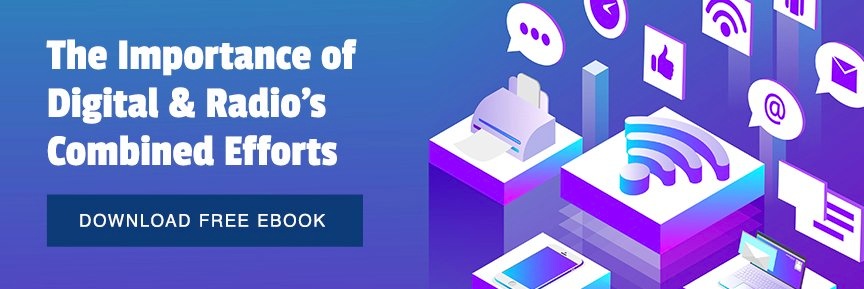Several years ago, market research company Colmar Brunton conducted a comparison study of different advertising channels about sales uplift.
What did these researchers find? They found that while standalone strategies that utilized only one advertising channel could yield some growth, a combination of radio and digital marketing was the most effective way to lift sales and increase revenues. In fact, a radio + digital mix caused an average of 23% sales uplift, compared to 9% from TV + digital, 17% from radio alone, 14% from digital alone, and 13% from television alone.
Of course, there was a wide range of effectiveness in the radio + online campaigns under examination. Merely taking the average uplift at face value can be misleading. The reality is, there are both effective and ineffective ways to integrate digital and radio advertising. If such an integration is performed the right way, then it is likely that the company will experience positive ROI at an average rate of 23% — or higher.
Why is the combination of radio and online advertising so effective? How can these two channels be effectively integrated?
Effective Integration of Radio and Digital Advertising
Both radio and digital marketing have their unique advantages and drawbacks in reaching consumers, engaging them, and ultimately converting them into customers. When businesses utilize these two channels in a unified strategy, their strengths feed off each other, and their limitations marginalized.
Radio
One of the key advantages of radio advertising is the ability to reach a wide, yet geographically-specific demographic with messaging around new brands or products. This effect amplifies when radio stations offer digital ads as a complement to traditional on-air spots. For instance, in 2019, radio digital ad sales surpassed $1 billion, representing 10% of total ad revenue in the industry.
Whether from traditional radio spots or digital ads, radio creative often serves as a "gateway" for consumers to begin an online search for a particular product, service, or company. These searches often lead consumers to landing pages through organic optimization (SEO) or pay-per-click ads (SEM). Once a consumer visits the landing page, retargeting pixels move him or her further along the consumer journey. These retargeting pixels (or "cookies") can track a visitor's behavior after he leaves the site, and cause-specific banner ads or other forms of marketing to appear on other sites he may visit later.
Digital
Digital advertising creates several touchpoints that can guide interested radio listeners down the sales funnel, and ultimately toward conversion.
Without a digital component in place, radio advertising can only provide a sales uplift if one of two things happens: a consumer calls the business or visits the store in person. Unfortunately, both of these reactions usually occur only if a consumer is either in the late evaluation stage or is ready to purchase. For most listeners in the awareness or early evaluation stages, neither of those options is very appealing.
This is where digital marketing can serve as a powerful supplement to radio advertisements. An optimized company website, for example, can enable prospects who are still educating themselves about the product to learn more in a low-pressure, low-effort setting. This may ultimately drive them to the next step of the consumer journey.
Consistency is Key
Consumers appreciate consistent messaging from a brand. By unifying their marketing message across all advertising channels, including radio, online, email marketing, SMS marketing and social media, companies foster a sense of familiarity within their target audience. Eventually, this sense of familiarity results in a positive response to the brand.
For instance, scientists have explored a phenomenon known as the "mere exposure effect." In basic terms, the more people see or hear something that they are otherwise neutral towards, the more they tend to like that thing. In the context of marketing, this finding underscores the essential nature of keeping a marketing message consistent across all channels. Most major corporations understand the advantages of doing so; if messaging or brand tone changes in one medium, they often change in all others as well.
The Importance of Effective Integration
Understanding the unique strengths of both radio and online advertising can help you to make the best possible marketing decisions for both channels. Also, never underestimate the potential impact that retargeting and consistent messaging can have. Inability or refusal to retarget bounced visitors can leave thousands upon thousands of dollars on the table. Without a familiar, consistent tone and message across all of your marketing channels, consumers will feel less affinity towards your brand.
On the other hand, effectively integrating your radio and digital advertising tactics as part of one consolidated strategy will likely lead to sales uplift, increased customer loyalty, and year over year growth for your business.

